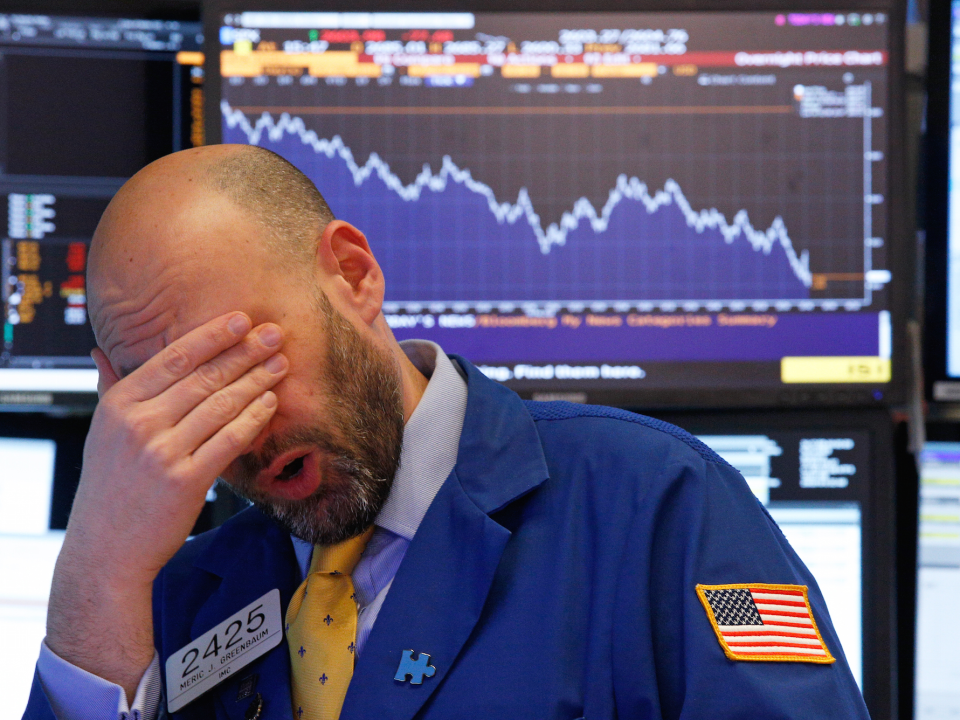Corporate earnings are crushing expectations and the market doesn't care
Corporate earnings in the fourth quarter have been stellar.
With 80.7% of the S&P 500’s market cap having reported earnings through the market close on Friday, February 9, 74% of companies are beating bottom-line estimates. Earnings are topping analyst expectations by an average of 4.8%. This is better than the 68% beat rate by an average of 4.7% seen over the last three years, according to data from Credit Suisse.
Credit Suisse also notes that earnings per share growth in the fourth quarter is expected to hit 15.3%, which would be the second-best quarter since the start of 2015.

But if current earnings beats relative to expectations hold through quarter-end, earnings per share could rise 15.9% against last year, which would be the strongest quarter for earnings growth since 2015.

Markets, however, have recently been enduring their most turbulent stretch in years, with the major averages falling more than 5% in the first full week of February. The nine-day drop of 10.04% from peak-to-trough seen through February 8 was the largest nine-day drop from an all-time high since at least 1980.
Disappointing market performance along with strong fundamentals — meaning good economic growth, good earnings, strong balance sheets, etc. — is not as surprising, however, as it might seem.
Strong earnings ≠ strong returns
In a note to clients earlier this month, Bank of America Merrill Lynch noted that strong earnings do not provide the kind of backing for strong stock market performance that many investors expect.
And earnings periods like the current one — in which the benefits of tax reform are helping corporate earnings grow by double-digits with expectations for the coming quarters continuing to rise — are exceptional and quickly discounted by investors.
“Over the past 90 years, the market has ended the year in negative territory 29 times,” Bank of America writes. “Of those 29 times, [earnings per share] was up almost 70% of the time and up double-digits close to 50% of the time. Over that same period, the correlation between annual S&P 500 performance and GAAP EPS is only 18%. If you lag EPS by one year, the correlation improves a bit to 42%, but even then, the corresponding r-squared implies that less than 20% of the S&P 500‘s annual performance is driven by earnings growth. We think that sentiment and growth expectations are a bigger driver of near-term returns, particularly late in bull markets.” (Emphasis added.)
Stock prices are a reflection of what investors are willing to pay for future earnings growth. The rally we saw in the stock market last year, then, was anticipating the future that exists right now.
In plain English, Bank of America’s work illustrates that by the time really strong earnings performance is realized by corporations — whether it be as a result of an improving economy, a policy change, or both — investors have already anticipated this change. And that by the time the non-investing public is seeing an abundance of good news about the economy and corporate America, the investing class has already started to prepare for the inevitable downturn.
When good news is bad news
The recent market turbulence comes not only during a time of strong corporate performance, but also a period when global economic growth through the end of the decade is expected to be at its best since the financial crisis. And while the fate of the financial market need not mirror that of the real economy, over the long run their fortunes are broadly related. Current market action, then, confounds the non-expert.
President Donald Trump last week tweeted, “In the ‘old days,’ when good news was reported, the Stock Market would go up. Today, when good news is reported, the Stock Market goes down. Big mistake, and we have so much good (great) news about the economy!”
Trump’s frustration over the market declining on what seems to be an abundance of good news about corporate America and real economy surely echoed a broad confusion from many outside the investing world as to what, exactly, is going on in markets.
But as hedge fund investor Ray Dalio detailed in a LinkedIn post on Monday, the relationship between markets and the economy reverses at the later stages of the economic cycle. Dalio contends that we’re currently in the late phase of the business cycle, where demand begins to exceed supply and prices are increased, thus stoking inflation and prompting central banks to raise interest rates more quickly.
Higher interest rates increase discount rates and can make riskier assets like stocks look less attractive on a relative basis. As Dalio writes, “That is why it is not unusual to see strong economies accompanied by falling stock and other asset prices, which is curious to people who wonder why stocks go down when the economy is strong and don’t understand how this dynamic works.”
Or as the old market adage says, good news is actually bad news.
—
Myles Udland is a writer at Yahoo Finance. Follow him on Twitter @MylesUdland
Read more from Myles here:
One candidate for Amazon’s next headquarters looks like a clear frontrunner
Tax cuts are going to keep being a boon for the shareholder class
Auto sales declined for the first time since the financial crisis in 2017
Foreign investors might be the key to forecasting a U.S. recession
It’s been 17 years since U.S. consumers felt this good about the economy
